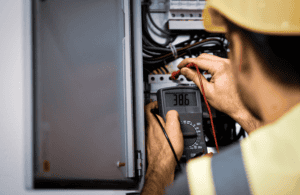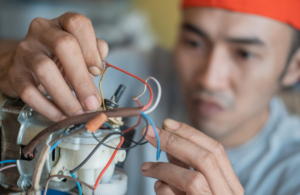
04 Apr Can My Older Home Handle Modern Electrical Demands?
Introduction
Many homes in Tulsa were built decades ago and may not be equipped to handle the electrical demands of today. As our reliance on electronic devices, appliances, and smart home technology increases, it’s more important than ever to ensure that your older home’s electrical system is safe and sufficient for modern use. An outdated electrical system can lead to inefficient power distribution, electrical hazards, and even costly repairs. So, how do you know if your home can handle the power needs of the modern world? In this blog, we’ll guide you through common issues with older electrical systems and how to upgrade them to safely meet today’s standards.
Common Issues with Older Electrical Systems
As charming and well-built as older homes are, their electrical systems were often designed with a very different power consumption in mind. Many homes built in the mid-20th century were not designed to handle the extensive electrical load that is typical today. The electrical needs of modern homes, which include everything from high-powered kitchen appliances to home theaters and smart home technology, can quickly overwhelm an older system. Here are some of the most common issues you may encounter:
1. Outdated Wiring (Knob-and-Tube, Aluminum Wiring)
Older homes often feature outdated wiring systems that pose safety risks and simply aren’t up to modern standards. Two of the most common types of old wiring found in these homes are knob-and-tube wiring and aluminum wiring.
Knob-and-Tube Wiring
Knob-and-tube wiring was the standard in homes built before the 1960s. It consists of two separate wires (a hot wire and a neutral wire) that run through ceramic knobs and tubes to keep them in place and insulated. While knob-and-tube wiring was effective in its time, it is now considered obsolete and unsafe. This type of wiring does not have a ground wire, which means it doesn’t offer the same level of protection from electrical faults as modern wiring. Over time, the insulation around the wires can degrade, creating an increased risk of shorts or fires.
Aluminum Wiring
Aluminum wiring was widely used in homes built between the 1960s and 1970s as a cheaper alternative to copper wiring. However, aluminum wiring is more prone to corrosion and overheating, especially at the connections. Overheated aluminum wiring can lead to dangerous fires. Although aluminum wiring is not necessarily dangerous on its own, it requires special care when it comes to connections and is no longer commonly used in modern homes. If your home has aluminum wiring, it’s important to consult with an electrician who can properly assess the safety of your system.
Both knob-and-tube and aluminum wiring do not meet current electrical codes and can pose serious risks if left unchecked. Upgrading these systems is essential to ensure safety in your home.
2. Limited Outlets

In older homes, you may notice that there are fewer outlets in each room, which can be a challenge in a modern world filled with gadgets, appliances, and electronics. Many older homes were built when electrical usage was minimal. People didn’t have to plug in as many devices, and appliances were typically smaller and less powerful.
Today, we have a range of electronics that require power outlets—computers, televisions, smartphones, and kitchen gadgets, to name just a few. If your home was built decades ago, you might be relying on extension cords or power strips to plug in your devices. While power strips are convenient, they can be a fire hazard when overloaded. Overloaded outlets and extension cords are one of the leading causes of electrical fires.
Having too few outlets can also lead to inconvenience, forcing you to move appliances or devices around to find available sockets. In many cases, you may need to have additional outlets installed to make your home safer and more functional.
3. Undersized Electrical Panels
Perhaps one of the most significant issues with older homes is their electrical panels. Electrical panels in homes built decades ago were designed to handle far less power than the ones we use today. For example, many homes still have 60-amp panels, while modern homes typically require 100-amp or 200-amp panels to meet electrical demands.
If your home has an older electrical panel, it may struggle to keep up with the power demands of modern appliances, high-powered electronics, and home comfort systems like air conditioning. A panel that is too small can result in frequent circuit breaker trips, power outages, and, in extreme cases, electrical fires.
Additionally, older panels may lack modern safety features, such as arc fault circuit interrupters (AFCIs) and ground fault circuit interrupters (GFCIs), which are designed to prevent electrical hazards. If your home’s electrical panel is outdated or undersized, it may be time to consider an upgrade to a modern panel that can support your current and future needs.
How to Upgrade an Older Home’s Electrical System
Upgrading an older home’s electrical system may sound like a major undertaking, but it’s an investment that can improve safety, enhance energy efficiency, and increase your home’s overall value. Here are a few key steps to consider when upgrading your system:
1. Install a New Breaker Panel
One of the first upgrades you may need to make is replacing your old breaker panel with a modern one. Replacing an outdated panel with one that has higher amperage (typically 100-200 amps) will ensure your home can handle the demands of modern appliances, electronics, and smart home technology. A new breaker panel will also provide better protection against electrical issues like overloads and short circuits.
Modern panels are also designed to be more energy-efficient, which can help reduce your overall electricity costs. Additionally, if your current panel doesn’t have AFCIs or GFCIs, upgrading to a newer model will improve the safety of your home by reducing the risk of electrical hazards.
2. Replace Old Wiring
If your home still has knob-and-tube or aluminum wiring, it’s crucial to replace it with copper wiring, which is safer and more reliable. Copper wiring is less prone to corrosion and overheating, making it the preferred option for modern electrical systems. Replacing old wiring can be a significant job, but it’s necessary for the safety of your home. An electrician will inspect your current system and assess what wiring needs to be replaced.
In some cases, rewiring may only be necessary for certain areas of the house, such as the kitchen or bathrooms. However, if the entire home has outdated wiring, a complete overhaul may be needed.
3. Add More Grounded Outlets
If your older home doesn’t have enough outlets, or if the outlets are ungrounded (which was common in homes built before the 1960s), it’s a good idea to have new, grounded outlets installed. Grounded outlets have three prongs and provide an additional layer of protection by safely redirecting any electrical surges to the ground. This prevents electrical shocks and reduces the risk of fires caused by faulty or overloaded outlets.
Installing new outlets can also reduce the need for extension cords and power strips, making your home safer and more convenient. If your home has a mix of old and new outlets, it’s also worth considering having them all replaced with up-to-date models that meet current electrical codes.
4. Consider Adding Surge Protection

Another important upgrade to consider is whole-home surge protection. Power surges, often caused by lightning strikes or utility issues, can damage your electronics and appliances. A surge protection system installed directly into your electrical panel can provide an extra layer of protection for your home, keeping your devices safe from electrical spikes.
When to Call a Professional
While it can be tempting to tackle electrical upgrades as DIY projects, it’s important to hire a licensed electrician for any electrical work. Electrical systems are complex, and improper installation or repairs can lead to dangerous situations, including electrical fires or shocks. A qualified electrician will assess your home’s wiring, panel, and overall electrical capacity to ensure that everything is up to code and capable of safely handling modern electrical demands.
If you are considering upgrading your electrical system, it’s always a good idea to get multiple estimates from reputable electricians to compare prices and services.
Conclusion
Many older homes in Tulsa have charming character, but their electrical systems may not be designed to meet the power needs of today’s modern household. Outdated wiring, limited outlets, and undersized electrical panels can put your home at risk for electrical hazards. Upgrading these systems is not just about increasing convenience, but also about ensuring the safety and functionality of your home for years to come.
By installing a new breaker panel, replacing old wiring, and adding grounded outlets, you can bring your older home up to modern electrical standards. Whether you are renovating, expanding, or simply ensuring the safety of your home, investing in an electrical upgrade is one of the smartest choices you can make for your property. Don’t wait until it’s too late—contact a licensed electrician today to assess your home’s electrical system and make the necessary upgrades to keep your home safe and efficient.